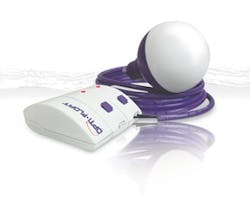Level Detector Offers Compact Design, Easy-to-Use Technology
The Opti-Float Mini is the newest addition to the Opti-Float line of level detectors. It boasts a more compact and cost-effective design than the original model while still maintaining many of its benefits.
Combining new technology with a familiar device, the Opti-Float level detector is an innovation in discrete level detectors. It is made of safe, recyclable materials; is mercury and lead free; and is built to last for years of service. The design of the Opti-Float level detector is simple. Using fiber-optic cable, it transmits a beam of light from an LED in a remote transceiver down to the float, where the beam makes and breaks depending on the tilt of the float. When the transceiver detects the presence or absence of light, it activates a relay in the transceiver, which can then operate other devices. Since the float does not have any electrical parts or wires, it cannot under any condition produce arcs or sparks and cannot cause an explosion, making it inherently safe. For the first time, floats can be used without the admission of electricity into an explosive area.
The Opti-Float Mini utilizes new “plug and play” technology, making it simple to install or upgrade any system. No special tools are required. An LED indicator light is positioned on each float transceiver so that the position of the float can be easily determined by simply looking inside of the control panel. Click here to watch a brief video about the Opti-Float Mini.
Contact Us
Cox Research and Technology Inc.
Baton Rouge, LA
800.910.9109
www.optifloat.com
